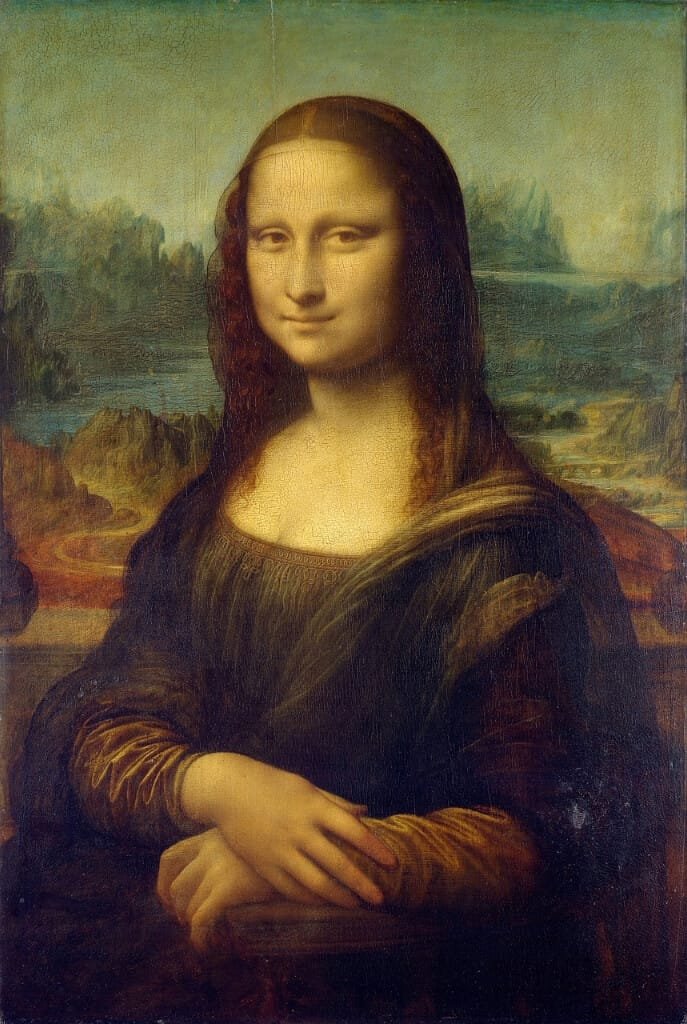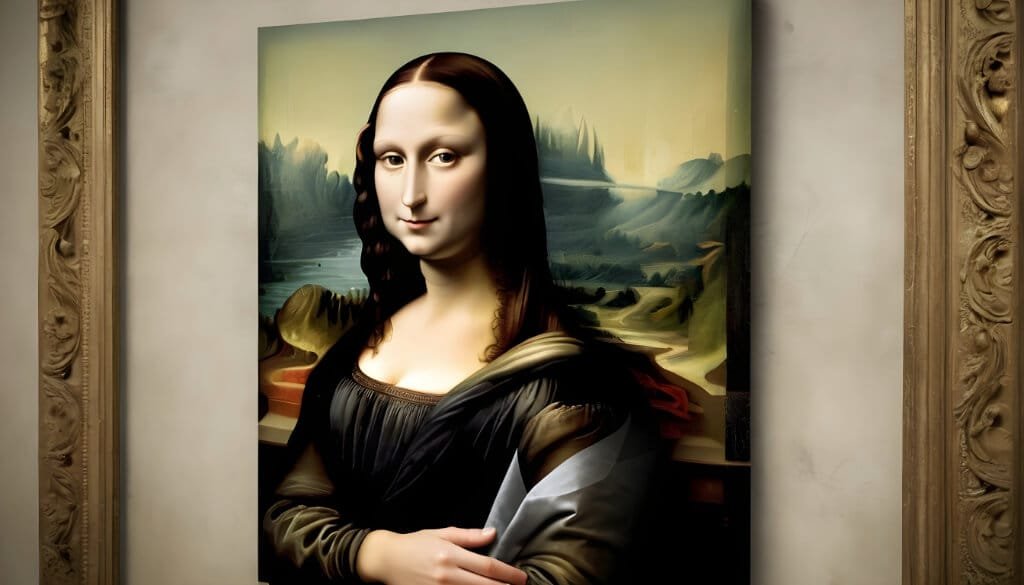The Mona Lisa mystery has intrigued art enthusiasts, historians, and scientists for centuries. Nestled within the Louvre Museum in Paris, Leonardo da Vinci’s masterpiece continues to captivate audiences worldwide with its enigmatic smile and timeless allure. Despite its fame, the Mona Lisa remains shrouded in mystery, with scholars and researchers delving into its secrets to uncover the truth behind its creation and symbolism.

The Artist Behind The Mystery
Leonardo da Vinci, the enigmatic polymath of the Renaissance, stands as the mastermind behind the Mona Lisa mystery. Born in Vinci, Italy, in 1452, da Vinci’s artistic prowess was matched only by his insatiable curiosity for the world around him. Renowned for his innovative techniques and keen observation of nature, da Vinci’s contributions to art, science, and engineering remain unparalleled.
Da Vinci’s artistic style, characterized by meticulous attention to detail and subtle nuances, is exemplified in the Mona Lisa. His use of sfumato—a technique involving delicate blending of colors and soft transitions between light and shadow—creates an ethereal quality in the painting, adding to the mystique surrounding the Mona Lisa’s enigmatic smile.
The connection between da Vinci’s life and the Mona Lisa further deepens the mystery. Scholars speculate about the identity of the woman portrayed in the painting, with some suggesting that she may have been a member of the Gherardini family, while others propose more esoteric interpretations. Regardless of the subject’s identity, da Vinci’s intimate involvement in the creation of the Mona Lisa suggests a personal significance that adds layers of intrigue to the artwork.
Da Vinci’s own life experiences and philosophies also inform our understanding of the Mona Lisa. His fascination with anatomy and human expression, coupled with his belief in the interconnectedness of all things, imbues the painting with a sense of universality and timelessness. As viewers contemplate the Mona Lisa’s enigmatic smile, they are drawn into a dialogue with da Vinci himself, grappling with questions of beauty, mortality, and the human experience.
In unraveling the Mona Lisa mystery, it becomes clear that da Vinci’s genius extends beyond his technical skill as an artist. He invites us to peer into the depths of his mind, where the boundaries between reality and imagination blur, and where the mysteries of existence are laid bare. The Mona Lisa serves as a testament to da Vinci’s enduring legacy—a testament that continues to captivate and intrigue audiences centuries after its creation.
The Enigmatic Smile
The Mona Lisa’s enigmatic smile is perhaps the most famous aspect of the painting, shrouded in mystery and subject to endless interpretation. Leonardo da Vinci’s mastery of expression is evident in the subtle curvature of the lips, which seem to flicker between a knowing grin and a sense of melancholy. This ambiguity has sparked fascination and debate among art historians, psychologists, and enthusiasts alike.
Describing the Mona Lisa’s smile is akin to capturing a fleeting moment in time. It is neither overtly joyous nor overtly sad but rather exists in a liminal space between emotions. The slight upturn of the corners of her mouth hints at amusement, while the delicate lines around her eyes suggest a deeper, introspective quality.
Throughout history, scholars and critics have offered myriad interpretations of the Mona Lisa’s smile. Some have posited that it reflects the sitter’s inner thoughts or emotions, while others believe it to be a deliberate expression crafted by da Vinci to convey a specific message. Freudian psychoanalysts have even analyzed the smile as a manifestation of the artist’s subconscious desires or anxieties.
Psychological studies of facial expressions in art have further fueled the debate surrounding the Mona Lisa’s smile. Researchers have examined factors such as gaze direction, lighting, and facial symmetry to unravel the secrets behind its allure. Yet, despite advances in technology and methodology, the enigmatic nature of the smile remains largely inscrutable.
One theory suggests that the Mona Lisa’s smile is a result of the “uncanny valley” effect—a phenomenon in which humanoid objects that closely resemble human beings elicit feelings of eeriness or discomfort. According to this interpretation, the ambiguity of the smile creates a sense of unease in the viewer, prompting them to project their own emotions onto the painting.
Regardless of the myriad theories and interpretations, the Mona Lisa’s smile continues to defy categorization. Its enigmatic quality transcends time and culture, inviting viewers to ponder the mysteries of human expression and perception. In the end, perhaps the true beauty of the Mona Lisa’s smile lies in its ability to elude explanation, forever tantalizing us with its elusive charm.
Historical Context
To truly grasp the significance of the Mona Lisa and its enduring enigma, one must delve into the rich tapestry of Renaissance Italy, where art, culture, and intellect flourished amidst a backdrop of political intrigue and societal change.
The Renaissance, meaning “rebirth,” marked a pivotal period in European history characterized by a revival of interest in classical learning, art, and humanism. Italy, the epicenter of this cultural reawakening, became a melting pot of ideas, attracting scholars, artists, and patrons from across the continent.
Patronage played a crucial role in the development of Renaissance art, with wealthy families and powerful rulers commissioning works of art to showcase their status and influence. The Mona Lisa, believed to have been commissioned by Florentine merchant Francesco del Giocondo, exemplifies the symbiotic relationship between artist and patron during this period.
The political and social climate of 16th-century Italy further shaped the context in which the Mona Lisa was created. Italy was a patchwork of city-states, each vying for power and dominance in a shifting landscape of alliances and rivalries. Against this backdrop of instability, artists like Leonardo da Vinci sought refuge and patronage in the courts of wealthy patrons, where they could pursue their craft free from the constraints of political turmoil.
The Renaissance also witnessed a revival of interest in human anatomy, philosophy, and scientific inquiry, as scholars sought to understand the natural world and the human condition. Leonardo da Vinci, with his insatiable curiosity and multidisciplinary approach, embodied the spirit of inquiry that defined this era, producing not only timeless works of art but also groundbreaking scientific discoveries and inventions.
In this historical context, the Mona Lisa emerges as more than just a portrait—it is a reflection of the cultural, political, and intellectual currents of Renaissance Italy. Its enigmatic smile encapsulates the complexity and ambiguity of the human experience, inviting viewers to contemplate the mysteries of existence and the passage of time.
As we unravel the historical context surrounding the Mona Lisa, we gain a deeper appreciation for its significance as a cultural artifact and a testament to the enduring legacy of the Renaissance. The Mona Lisa mystery, inextricably intertwined with the fabric of history, continues to captivate and inspire audiences around the world, reminding us of the power of art to transcend time and space.

Scientific Investigations
The allure of the Mona Lisa mystery has not escaped the scrutiny of modern science, which has brought cutting-edge technology to bear in unraveling the secrets of this iconic masterpiece.
Technological advancements in art analysis have revolutionized our understanding of the materials and techniques used by Renaissance artists. Through techniques such as infrared reflectography, X-ray fluorescence spectroscopy, and multispectral imaging, researchers have gained unprecedented insight into the composition of the Mona Lisa and the methods employed by Leonardo da Vinci.
One of the most significant scientific investigations into the Mona Lisa involved a comprehensive analysis of the painting’s materials and pigments. Researchers used non-invasive techniques to study the layers of paint, revealing details about da Vinci’s palette, brushwork, and artistic process. These findings shed light on the meticulous craftsmanship behind the Mona Lisa and deepened our appreciation for da Vinci’s skill as a painter.
Another area of scientific inquiry has focused on the preservation and conservation of the Mona Lisa. In recent years, conservationists have employed state-of-the-art imaging technology to monitor the painting’s condition and identify potential threats to its long-term stability. By studying factors such as temperature, humidity, and light exposure, researchers can develop strategies to ensure the Mona Lisa remains intact for future generations.
Perhaps most intriguingly, scientific investigations have offered new insights into the enigmatic smile of the Mona Lisa. Psychologists have utilized facial recognition software and eye-tracking technology to analyze the subtle nuances of the smile and its impact on viewers. These studies have revealed fascinating patterns in how people perceive and interpret the Mona Lisa’s expression, shedding light on the psychological mechanisms at play.
Yet, for all the advances in scientific analysis, the Mona Lisa mystery remains tantalizingly unresolved. While technology has provided valuable clues and generated new theories, the true meaning behind the enigmatic smile continues to elude definitive explanation. In the end, perhaps it is this very mystery that ensures the enduring fascination of the Mona Lisa, drawing us ever deeper into its enigmatic gaze.
Theories And Speculations
Over the centuries, the Mona Lisa’s enigmatic smile has inspired a plethora of theories and speculations, each offering its interpretation of this iconic masterpiece.
One of the most enduring theories revolves around the identity of the woman depicted in the painting. While some scholars believe her to be Lisa Gherardini, the wife of Florentine merchant Francesco del Giocondo, others have proposed alternative candidates, ranging from members of the Medici family to allegorical representations of femininity. This ambiguity has fueled speculation about the true identity of the sitter and her relationship to Leonardo da Vinci.

Another area of speculation centers on the meaning behind the Mona Lisa’s smile. Some interpret it as a reflection of inner contentment or amusement, while others see hints of melancholy or mystery. Freudian psychoanalysts have delved into the subconscious motivations behind the smile, suggesting that it may be a manifestation of da Vinci’s psychological state or desires.
Conspiracy theories abound when it comes to the Mona Lisa, with some suggesting that the painting contains hidden messages or symbols encoded by da Vinci himself. From secret codes concealed within the composition to theories about hidden self-portraits lurking beneath the surface, these speculations add an aura of intrigue to the Mona Lisa mystery.
One particularly intriguing theory proposes that the Mona Lisa is part of a larger artistic project, with da Vinci conceiving of it as a multi-layered puzzle meant to be deciphered by future generations. According to this interpretation, clues embedded within the painting lead to hidden truths or revelations about the nature of reality and the human condition.
While each theory offers its perspective on the Mona Lisa mystery, the true meaning of the painting’s enigmatic smile may ultimately lie beyond the grasp of human understanding. As viewers continue to ponder and speculate, the Mona Lisa remains a testament to the enduring power of art to provoke thought, inspire wonder, and spark imagination. In the end, perhaps it is this very mystery that ensures the timeless allure of Leonardo da Vinci’s masterpiece.
Cultural Impact
The Mona Lisa’s enigmatic smile transcends its status as a mere painting, permeating popular culture and leaving an indelible mark on society.
Since its creation, the Mona Lisa has captured the imagination of artists, writers, and filmmakers, inspiring countless works of art and literature. From parodies and pastiches to homages and reinterpretations, the Mona Lisa has become an enduring symbol of artistic genius and creative expression.
In the realm of popular culture, the Mona Lisa has been appropriated and reimagined in a myriad of ways. Its image has appeared on everything from coffee mugs and t-shirts to advertisements and album covers, cementing its status as an icon of global culture. The Mona Lisa’s enigmatic smile has become shorthand for mystery and intrigue, instantly recognizable to people around the world.
The painting’s cultural impact extends beyond the realm of art and entertainment, influencing fields as diverse as psychology, philosophy, and sociology. Scholars have analyzed the Mona Lisa’s smile through the lens of emotion theory, exploring its effects on perception and cognition. Philosophers have pondered the nature of beauty and aesthetic experience, using the Mona Lisa as a touchstone for discussions about art and meaning.
In the digital age, the Mona Lisa has found new life on the internet, where memes and viral videos spread its image far and wide. Social media platforms have become virtual galleries, where users share their interpretations of the Mona Lisa and engage in spirited debates about its significance. The painting’s omnipresence in online culture ensures that its legacy will endure for generations to come.
Beyond its immediate cultural impact, the Mona Lisa has also played a role in shaping modern perceptions of art and its place in society. By transcending the confines of the museum and entering the realm of mass media, the Mona Lisa challenges traditional notions of artistic authenticity and originality. Its ubiquity in popular culture raises questions about the commodification of art and the role of the artist in contemporary society.
The Mona Lisa’s cultural impact is a testament to its enduring power to captivate and inspire audiences across time and space. From its humble origins in Renaissance Italy to its status as a global icon, the Mona Lisa continues to fascinate and intrigue, reminding us of the profound influence that art can have on the human experience.
Final Thoughts
In conclusion, the Mona Lisa mystery continues to captivate audiences worldwide, inviting speculation and interpretation. As scholars and researchers delve deeper into its secrets, the enigmatic smile of Leonardo da Vinci’s masterpiece remains as compelling as ever. Whether contemplating its artistic brilliance or unraveling its historical significance, the Mona Lisa continues to inspire wonder and fascination, ensuring its place as one of the most iconic works of art in human history.
FAQs
What Makes The Mona Lisa’s Smile So Mysterious?
The Mona Lisa’s smile is enigmatic due to its subtle yet captivating expression, which has sparked centuries of debate among scholars and art enthusiasts. Leonardo da Vinci’s mastery of sfumato, a technique that blurs the lines between light and shadow, adds to the painting’s air of mystery.
Who Was The Subject Of The Mona Lisa?
A: While the identity of the Mona Lisa’s subject is not definitively known, many scholars believe it to be Lisa Gherardini, the wife of Florentine merchant Francesco del Giocondo. However, alternative theories suggest that the painting may depict an idealized figure or a symbolic allegory.
What Techniques Have Scientists Used To Investigate The Mona Lisa?
Scientists have employed various techniques, such as infrared reflectography and multispectral imaging, to examine the Mona Lisa’s composition and pigments. These scientific investigations have provided insights into Leonardo da Vinci’s creative process and shed light on the painting’s mysteries.
Why Is The Mona Lisa So Famous?
The Mona Lisa is renowned for several reasons, including Leonardo da Vinci’s masterful technique, the enigmatic expression of the subject, and its status as an iconic symbol of art and culture.
What Is The Meaning Behind The Mona Lisa’s Smile?
The meaning of the Mona Lisa’s smile has been the subject of much speculation and debate. Some interpret it as a reflection of inner contentment or mystery, while others see hints of melancholy or amusement. Ultimately, the true meaning may remain open to interpretation.
Is The Mona Lisa The Most Valuable Painting In The World?
While the Mona Lisa is undoubtedly one of the most famous and valuable paintings in the world, its exact value is difficult to determine. Its cultural significance, historical importance, and rarity contribute to its high value, but other factors also play a role in determining its worth.
Also Read: Who Invented IQ Tests?
